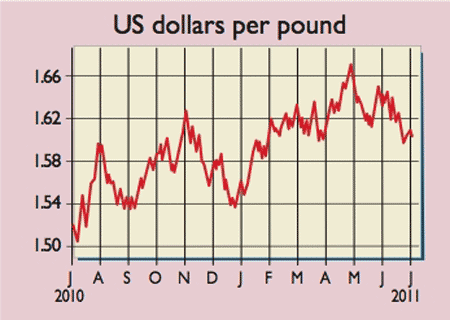
The latest economic data suggest that the recovery has lost momentum. The monthly index of purchasing managers (PMI) tracking the manufacturing sector slid to 51.3 in June – the lowest reading since September 2009. A reading of 50 or above indicates that the sector is expanding. The PMI for the services sector inched up to 53.8, although it is still down on its March high. The labour market held up, but seems to be weakening. A survey by the Recruitment & Employment Confederation and accountants KPMG found that permanent recruitment rose at its slowest pace in two years.
What the commentators said
Economists are now pencilling in a growth rate of 0.3% in the second quarter, down from 0.5% in the first. That would be “very disappointing” for this stage of a recovery, said Andrew Goodwin of the Ernst & Young Item Club. “The weakest link”, said Bloomberg.com, is consumption, which accounts for around 60% of the economy. Households are still highly indebted and concentrating on improving their personal balance sheets, noted Howard Archer of IHS Global Insight. They paid back £5.8bn of housing debt in the first quarter – 2.3% of their net income. Moreover, high inflation and tax increases are squeezing real incomes. No wonder spending dropped by the most in almost two years in the first quarter.
Even the 1.7% expansion this year projected in the Budget looks a stretch now, said Sean O’ Grady in The Independent, and next year’s forecast of 2.5% is also starting to look optimistic. There is a danger that the government will have to borrow more than it has anticipated. Faced with “such an array of negative data”, the Bank of England has become much more dovish, added David Prosser in the same paper. A return to quantitative easing, or money printing, is now on the table.
Jitters over the outlook have made the pound “the whipping boy” on the foreign-exchange market, said Peter Garnham in the FT. It has slid to a five-month low against the dollar at around $1.59 and has also hit a 16-month low against the euro. One problem is that Britain has been a relative safe haven during the European sovereign-debt crisis, thanks to its plan to cut its budget deficit. If this appears in danger of being derailed, sterling suffers.
Changing interest-rate expectations are also playing a part, said Fxpro.com. There is likely to be further talk of quantitative easing in Britain, so a rate hike looks even further off. Meanwhile, the European Central Bank has already raised interest rates and sounds more hawkish on inflation. Given the uncertain outlook for the British economy, “it is difficult to see why the pound would strengthen anytime soon”. Morgan Stanley’s Tim Davis expects the pound to slide to $1.49 by the end of the year.